The M32 ARV was the second (Armoured) Recovery Vehicle fielded by the US Army during WW2, better refined with early experience in this very new field of research. It was to succeed the M31 ARV based on the now obsolete M3 Lee Medium Tank, and produced on the M4, M4A1 (cast hull) and also M4A2, A3 shermans. More were built (1562) from late 1943 to 1945 than any other type. They served in Sicily-Italy by the fall of 1943, France from the summer of 1944, and Germany in 1945 but not the Pacific. They had a set of well-thought tricks which really setup a standard at the time.
The first true ARVs thus, appeared in World War Two fielded by nearly all large warring nations. Even though the vehicles retrieved were all repairable, at least they constituted a reserve of spare parts to be cannibalized. The United States was thus devised the US Army Recovery and Repairs Management. The British and Germans showeved the way in WW1 already, the latter reusing more British Tanks that they ever produced some, also as artillery tractors, while some British Mark IVs received jibs and became impromptu "salvage tanks" in 1917, to try to recovered damaged tanks in the no-man's land. Quite a risky proposition, but they operated more freely in 1918 after the Allied counter-offensive.
A panel of common US WW2 recovery vehicles
The US Army in the interwar practically put a stop to all tank production, or even tactical exercizes. This situation changed however in 1940 as the US Army staff thought of seting up a similar organization for a possible future engagement. This however largely stayed at literrature levels. Only combat tanks or "armoured cars" prototypes were tested between Rockland and Aberdeen and no serious concern was given for the service until the US were found at war in December 1941.
During WW2 British service setup such organization in North Africa. The USA only started their land campaign in North Africa and still did not seriously considered setting up a proper recovery organization before heavier engagements in early 1943, notably after Kasserine Pass. It was established as a division of the Ordnance Corps, supplying Army combat units and watched over procurement and field maintenance.
It was thought at first to assigned this task of recovering tanks to to the Quartermaster Corps and Transportation Corps, (logistics branch) and they made due on the field with artillery towing tractors, pressing in service M6/M6 HS Tractors but also trucks such as the Mack NO4/5 7½-ton 6x6 and International H542-9 4×2 Tractor Truck with its Fruehauf CPT-22 semi-trailer, or the C2 Wrecker, and later heavy M26 ARV truck. Recovery trucks were not new and went back well before, but US manufacting was able to go from large tank transport trucks (linking controlled railways with the front) to salvage trucks rapidly, and developments in this field went on until 1945. However these had a crucial problem: They were soft-skinned, meaning easy prey for any enemy troop or aircraft, even light vehicles.
It was soon recoignised that battlefield conditions not only favoured tracked vehicles for the terrains they were to evolve, unlike trucks more easily bogged, but also offiering the required protection to carry out recoveries very close to a shifting frontline. Plans for tracked armoured recovery vehicles would logically led to the design of a dedicated vehicle but since it was considered a waste of time and resource for a "second line job", and these were urgently needed, it was decided to sumply converted exiting tanks, those notably obsolete or already damaged and turret-less.
The basic prototypes from Lima Locomotive and were accepted on January 11, 1943. They competed at the time against rival T2 and T7 designs having a turret mounted boom like the M31 ARV. The T5 was declared superior to the T2 and T7 designs after weeks and the final pre-acceptance prototypes T5 and T5E1 were sent to Aberdeen and at Camp Hood, Texas for the T5E2, or Camp Seely in California for the T5E4, offering extreme differences in weather and temperatures. During testing the T5E3 had an engine failure and was abandoned.
By June 1943, the Ordnance Committee standardized the designs of all these Sherman-based prototypes T5, T5E1, T5E2, T5E3, T5E4 as M32, M32E1, M32E2, M32E3, M32E4 and terminated the rival T7 project. The M32, based on a soon obsolete base was not however chosen as main production base. It was to be followed during wartime and pretty much until the Korean War by other variants. But that's the M4A1 caracterized by its cast hull instead of welded, angular plates, that saw the largest production of all. The choice had several reasons, notably that by late 1942 it was already seen obsolescent (yet still produced unlike the M4) and programmed to be replaced by the M4A3 and M4A5. The cast hull was not seen as a frontline success also, reporting fracturing hulls after impact on the battlelfield.
The M32E1, M32E2, M32E3, and M32E4 were also tested at Aberdeen on different Sherman variants, with the latter staying at paper stage. Sub-variants had Horizontal Volute Spring Suspension (HVSS) earning the "A1" after the model number, like the M32E3A1 commonly found in Korea. This ended with a "menagerie" of nine main variants, one prime mover, and two "minesweepers". The "B" had HVSS suspensions, and it seems many were retrofitted later in the war with these, burrying the exact production figures for the whole M32.
-Pressed Steel Car was also joined into this production, and converted 163 M32s and 475 M32B1s in 1944 and 298 M32B3s until 1945.
-Baldwin Locomotive Works later joined the fray with 180 M32B1s -Federal Machine and Welder Company also delivered 400 M32B1s before the end of 1944.
In addition, twenty four M32B1s were converted into M34 Prime Movers for heavy artillery.
The M31 had been a precious experience and by mid-1942, the US Army Recovery and Repairs Management was looking at improving the concept, using as many battlefield reports as possible, and a more common, actual base as replacement. The choice naturally fell to the new standard M4 Sherman tank. When first tests were launched, and soon, the M4A1 was chosen as a base for the next evolution, caracterized by its cast hull instead of welded, angular plates. The choice had several reasons, notablt that by late 1942 it was already seen sobsolescent and programmed to be replaced by the M4A3 and M4A5. The cast hull was not seen as a success also, many fracturing after impact. However the M4A2, A3 and A4 were also chosen, with the last fitted with HVSS suspensions.
The M32 Tank Recovery Vehicle (TRV, not ARV as adopted postwar) added to the base M4A1 a 18 ft (5.5 m) boom as well as A-frame jib, and 30-short-ton (27 t) winch for practical operations plus a turret-like structure to contain part of the gear. It was topped by two hatches for the commander and main operator, the former with a ring mount for its only defensive armament, a cal.50 Browning M1920.
The base vehicle was otherwise 19.3 ft (5.9 m) long but 18 ft (5.5 m) more (37.3 feet or 11,4 meters) boom fully extended. Its width was kept at 8.9 ft (2.7 m) and height 9.66 ft (2.94 m), leaning it was a bit less conspicuous than the original Sherman... The weight differed between versions, at 64,300 lb (29,200 kg) for the first M32, M32B1, M32B3 but 67,600 lb (30,700 kg) for the M32B2 based on the longer M4A2. Equipments throughout these versions stayed the same essentially.
In all cases, the power unit was however standardized to a Spicer manual synchromesh transmission, with one reverse and five forward gears. The drivetrain did not changed and comprised a set of six roadwheels on bogies, with VVSS as standard at first and later HVSS (see below). Drive sprockets are the front close to the tranmission, idlers at the rear and three return rollers. Tracks were standard M4 with single pin, but they benefitted from 1944-45 improvements, with grounsers and extensions to better cope with mud and snow. VVSS were common for most of the production (Vertical Volute Spring) but it swapped on HVSS (Horizontal Volute Springs) later starting with retrofitting all extant M32 as M32A1 in 1945. Other models benefitted from the upgrade later, often with new extended tracks for better grip. Still, the majority of Earlier M32B1s had narrow tracks and struggled on mud and snow.
*Also used by the British in lend lease as ARV Mark III.
**Assigned to heavy artillery units like the 240 mm howitzer. No armament, four seats, tail lights, electric outlets for stopping of towed loads and stowage ports. Limited production 1944-45.
***The T1E1 Mine Exploder "Earthworm" was developed in late 1943 based on the first M32, with different trailing discs compared to the original T1. Only a few were made and used notably at D-Day.


M32A1 with side skirts on an ONI plate

Overview of the M32A1 ring mount M66 at Aberdeen Dec. 1944

M32B3, ONI ordnance doc.

M32B1
The M32 entered service in July 1943, Sicily ad the whole Italian Campaign. The M32s were first used in large numbers in Operation Overlord (D-Day, 6 June 1944) and throughout the European Theater, including northern Italy. As for the Pacific, it was used at at Iwo Jima with the 5th TB and at Okinawa with the 6th Tank Battalion. It seems the USMC was also supposed to receive some for the final offensive (Operation Olympic) which was estimated very costly. The remainder were HVSS conversions used by the US Army. There was also the T1E2 Minesweeper developed for the USMC in 1943 which never was produced.

Lifting a pre-fabricated bridge section, France 1944
The vehicle was also provided to the british Royal Army in lend-lease, of the M32B1 type (based on the M4A1) and locally designed as ARV Mark III. It seems they were deployed in Italy. By 1944, the Ordnance Department tested a replacement for the M32 with a heavier vehicle which was tested on the base of the new M26 heavy tank Pershing as the T12 Armored Recovery Vehicle. Unlike the M33 ARV, it was found too expensive and never produced.
Used by IDF, Suez crisis 1956
The Korean war ended, but not the use of the M32. There were thousands of M4 Shermans of all variants in the mothballs after WW2. Thus many potential buyers on the troubled postwar years. All these new buyers for the Sherman (Chile kept its own until the 1990s...) also needed the M32 for recovering these and thus, they saw action in the Suez Crisis (On the French and Israeli sides), but also in the Six-Day and Yom Kippur War as IDF needed to tow its M51 Super Shermans. The Mexican Army nicknamed them "Chenca" and used these until 1998. The U.S. loaned these postwar. Yugoslavia also acquired M32/M32Bs in the Informbiro period, in which the regime obtained dozens of Shermans. The M32 and variants were also used by Indonesia and Japan. The latter for the early years of the JSDGF. The country indeed received 250 M4A3(76)W HVSS "Easy Eight" Shermans and 80 of M32 TRV in 1954. They were discarded in the 1970s as no longer able to care for the new Japanese MBTs such as the Type 61 and 74 MBTs.
The second US ARV
The ARV (Armoured Recovery Vehicle) type was born with the mass of tanks which needed care or retrieval on the battlefield in WW2. This was a task to save them to receive more extensive repairs behind the frontline and return to service, a needed that appeared evident with the losses of Tanks during their perislous crossing from US Manfufacting plant to frntline Europe or Africa. Many were sent to the bottom by Dönitz feared U-Boats. This seemed a sensible moved to retrieve extra tanks directly from the battlefield, especially if they were largely intact and just broke down.The first true ARVs thus, appeared in World War Two fielded by nearly all large warring nations. Even though the vehicles retrieved were all repairable, at least they constituted a reserve of spare parts to be cannibalized. The United States was thus devised the US Army Recovery and Repairs Management. The British and Germans showeved the way in WW1 already, the latter reusing more British Tanks that they ever produced some, also as artillery tractors, while some British Mark IVs received jibs and became impromptu "salvage tanks" in 1917, to try to recovered damaged tanks in the no-man's land. Quite a risky proposition, but they operated more freely in 1918 after the Allied counter-offensive.
US Army Recovery and Repairs Management

A panel of common US WW2 recovery vehicles
The US Army in the interwar practically put a stop to all tank production, or even tactical exercizes. This situation changed however in 1940 as the US Army staff thought of seting up a similar organization for a possible future engagement. This however largely stayed at literrature levels. Only combat tanks or "armoured cars" prototypes were tested between Rockland and Aberdeen and no serious concern was given for the service until the US were found at war in December 1941.
During WW2 British service setup such organization in North Africa. The USA only started their land campaign in North Africa and still did not seriously considered setting up a proper recovery organization before heavier engagements in early 1943, notably after Kasserine Pass. It was established as a division of the Ordnance Corps, supplying Army combat units and watched over procurement and field maintenance.
It was thought at first to assigned this task of recovering tanks to to the Quartermaster Corps and Transportation Corps, (logistics branch) and they made due on the field with artillery towing tractors, pressing in service M6/M6 HS Tractors but also trucks such as the Mack NO4/5 7½-ton 6x6 and International H542-9 4×2 Tractor Truck with its Fruehauf CPT-22 semi-trailer, or the C2 Wrecker, and later heavy M26 ARV truck. Recovery trucks were not new and went back well before, but US manufacting was able to go from large tank transport trucks (linking controlled railways with the front) to salvage trucks rapidly, and developments in this field went on until 1945. However these had a crucial problem: They were soft-skinned, meaning easy prey for any enemy troop or aircraft, even light vehicles.
It was soon recoignised that battlefield conditions not only favoured tracked vehicles for the terrains they were to evolve, unlike trucks more easily bogged, but also offiering the required protection to carry out recoveries very close to a shifting frontline. Plans for tracked armoured recovery vehicles would logically led to the design of a dedicated vehicle but since it was considered a waste of time and resource for a "second line job", and these were urgently needed, it was decided to sumply converted exiting tanks, those notably obsolete or already damaged and turret-less.
Predecessor: The M31 ARV
This led to the development of the M31 ARV based on the Medium Tank M3 lee available in significant numbers but obsolete at the end of 1942 and still active in the far east while its chassis was used for the M4 Sherman. This stopgpap tank with hull-mounted howitzer and light gun turret was indeed less than idea, and the exiting chassis were converted to many applications, the basic M31 Tank Recovery Vehicle (Grant ARV I in British service) and sub-variants M31B1/B2 TRV, M33 Prime Mover, M7 Priest, GMC M12 T6 or M30 Cargo Carrier. In all 800 M31 were converted in 1942-43 and soon were seen in North Africa, soldiering also in Sicily and Italy. One its preculiarities was a dummy turret containing the main jib crane apparatus, fitted with a dummy gun on it and another welded tube on the sponson to look like a regular M3 Lee.Development
The M31 had been a precious experience and by mid-1942, the US Army Recovery and Repairs Management was looking at improving the concept, using as many battlefield reports as possible, and a more common, actual base as replacement. They also looked at the British BARV/AVRE but wanted a domestic production for standardization. The choice naturally fell to the new standard M4 Sherman tank.The basic prototypes from Lima Locomotive and were accepted on January 11, 1943. They competed at the time against rival T2 and T7 designs having a turret mounted boom like the M31 ARV. The T5 was declared superior to the T2 and T7 designs after weeks and the final pre-acceptance prototypes T5 and T5E1 were sent to Aberdeen and at Camp Hood, Texas for the T5E2, or Camp Seely in California for the T5E4, offering extreme differences in weather and temperatures. During testing the T5E3 had an engine failure and was abandoned.
By June 1943, the Ordnance Committee standardized the designs of all these Sherman-based prototypes T5, T5E1, T5E2, T5E3, T5E4 as M32, M32E1, M32E2, M32E3, M32E4 and terminated the rival T7 project. The M32, based on a soon obsolete base was not however chosen as main production base. It was to be followed during wartime and pretty much until the Korean War by other variants. But that's the M4A1 caracterized by its cast hull instead of welded, angular plates, that saw the largest production of all. The choice had several reasons, notably that by late 1942 it was already seen obsolescent (yet still produced unlike the M4) and programmed to be replaced by the M4A3 and M4A5. The cast hull was not seen as a frontline success also, reporting fracturing hulls after impact on the battlelfield.
The M32E1, M32E2, M32E3, and M32E4 were also tested at Aberdeen on different Sherman variants, with the latter staying at paper stage. Sub-variants had Horizontal Volute Spring Suspension (HVSS) earning the "A1" after the model number, like the M32E3A1 commonly found in Korea. This ended with a "menagerie" of nine main variants, one prime mover, and two "minesweepers". The "B" had HVSS suspensions, and it seems many were retrofitted later in the war with these, burrying the exact production figures for the whole M32.
Production
The manufacturer chosen for the conversion was Lima Locomotive Works in Ohio, starting production by June 1943 of five pilot vehicles (each model described above) including the M32B4. They also delivered pre-series, 26 M32B2s, and 20 M32B3s.-Pressed Steel Car was also joined into this production, and converted 163 M32s and 475 M32B1s in 1944 and 298 M32B3s until 1945.
-Baldwin Locomotive Works later joined the fray with 180 M32B1s -Federal Machine and Welder Company also delivered 400 M32B1s before the end of 1944.
In addition, twenty four M32B1s were converted into M34 Prime Movers for heavy artillery.
Design

The M31 had been a precious experience and by mid-1942, the US Army Recovery and Repairs Management was looking at improving the concept, using as many battlefield reports as possible, and a more common, actual base as replacement. The choice naturally fell to the new standard M4 Sherman tank. When first tests were launched, and soon, the M4A1 was chosen as a base for the next evolution, caracterized by its cast hull instead of welded, angular plates. The choice had several reasons, notablt that by late 1942 it was already seen sobsolescent and programmed to be replaced by the M4A3 and M4A5. The cast hull was not seen as a success also, many fracturing after impact. However the M4A2, A3 and A4 were also chosen, with the last fitted with HVSS suspensions.
The M32 Tank Recovery Vehicle (TRV, not ARV as adopted postwar) added to the base M4A1 a 18 ft (5.5 m) boom as well as A-frame jib, and 30-short-ton (27 t) winch for practical operations plus a turret-like structure to contain part of the gear. It was topped by two hatches for the commander and main operator, the former with a ring mount for its only defensive armament, a cal.50 Browning M1920.
The base vehicle was otherwise 19.3 ft (5.9 m) long but 18 ft (5.5 m) more (37.3 feet or 11,4 meters) boom fully extended. Its width was kept at 8.9 ft (2.7 m) and height 9.66 ft (2.94 m), leaning it was a bit less conspicuous than the original Sherman... The weight differed between versions, at 64,300 lb (29,200 kg) for the first M32, M32B1, M32B3 but 67,600 lb (30,700 kg) for the M32B2 based on the longer M4A2. Equipments throughout these versions stayed the same essentially.
Powerplant & performances
The engine varied between variants but the most common M32B1 (M4A1) featured the C4 9-cylinder radial gasoline engine, running at 2,400 rpm, whereas the M32/M4 had a Continental R975-C1). Next M32B2 were powered by a General Motors 6046 twin diesel, the M32B3 a Ford GAA V8 which ran the highest at 2,600 rpm. Thus they diverged in capabilities, having a range of circa 120–150 mi (190–240 km) based on 148–175 US gal (560–660 L) and top speed of 24 mph (39 km/h).In all cases, the power unit was however standardized to a Spicer manual synchromesh transmission, with one reverse and five forward gears. The drivetrain did not changed and comprised a set of six roadwheels on bogies, with VVSS as standard at first and later HVSS (see below). Drive sprockets are the front close to the tranmission, idlers at the rear and three return rollers. Tracks were standard M4 with single pin, but they benefitted from 1944-45 improvements, with grounsers and extensions to better cope with mud and snow. VVSS were common for most of the production (Vertical Volute Spring) but it swapped on HVSS (Horizontal Volute Springs) later starting with retrofitting all extant M32 as M32A1 in 1945. Other models benefitted from the upgrade later, often with new extended tracks for better grip. Still, the majority of Earlier M32B1s had narrow tracks and struggled on mud and snow.
Protection
The base protection did not changed from the original bases. The armor ranged from 0.5-inches (roof, engine deck, belly) to 2 inches (13–51 mm) from the sides to the front. The main armament was gone, and was now limited to a 81 mm mortar used to cover emergency retreats and only firing smoke rounds. Main armament was a single 0.5 in (12.7 mm) M2 Browning machine gun mounted on top of the "turret" on a skid rail, and the original hull-mounted 0.3 in (7.6 mm) M1919 machine gun. To go with the mortar, the vehicle was supplied with 20 hand grenades (Fragmentation Mk.II) for additional defence, as well as six smoke grenades. Of course there was the personal M1911A1 pistol as a side arm and at that stage in the war, not the M1928A1 Thompson but more likely three compact, small close defence M3 submachine guns ("grease gun").Equipments
In addition to the mortar, more for protection than attack, the M32 main equipments were a 30 short tons (27 t) winch, a 18 ft (5.5 m) boom derived from the one of the M31 AV, and an solid A-frame jib. It was at least capable of recovering and towing off any M4 Sherman Tank or any vehicle of this size and standard (self propelled guns notably) as well as obviously lighter tanks such as the M3 and M5 Stuarts, and M24 Pershing. However it was unable to recover a M26 Pershing heavy tank. This was the job of heavy trucks like the Dragon. It is not unheard of salvaging and towing off such tank using two M32s. But there are not photos showing this so far.Variants
| M32 | Original on M4 Sherman, 163 were produced by Pressed Steel Car 1944 |
| M32B1 | M4A1. 1,085 produced by Federal Mach., Baldwin, Pressed Steel Car*. |
| M32B2 | Rare one based on the M4A2. 26 by Lima Locomotive |
| M32B3 | Based on M4A3, 344 by Lima Locomotive, Pressed Steel Car |
| M32B4 | M4A4 with Chrysler Multibank engine, never made. |
| M32A1 | M32 with HVSS suspension, later conversions |
| M32A1B1 | M32B1 with HVSS suspension, 175 by Baldwin Locomotive |
| M32A1B2 | M32B2 with HVSS suspension |
| M32A1B3 | M32B3 with HVSS suspension |
| M34 PM** | M34 Prime Mover (no towing cable) for pulling arty into place. |
| T1E1 Minesweeper | A Mine exploder vehicle with T1 equipment in the boom*** |
| T1E2 Minesweeper | Same but with T2 mine exploder, developed for the Marines, not produced. |
**Assigned to heavy artillery units like the 240 mm howitzer. No armament, four seats, tail lights, electric outlets for stopping of towed loads and stowage ports. Limited production 1944-45.
***The T1E1 Mine Exploder "Earthworm" was developed in late 1943 based on the first M32, with different trailing discs compared to the original T1. Only a few were made and used notably at D-Day.
M32B1 ARV specifications | |
| Dimensions (L-W-H) | 19.3 x 8.9 x 9.66 ft (5.9 x 2.7 x 2.94 m) |
| Weight | 64,300 lb (4,590 st), c30 tonnes |
| Crew | 4: driver, commander, 2 operators |
| Propulsion | Continental R975-C1/C4 9 cyl. radial 350/400 hp |
| Top speed | 24 mph (39 km/h) |
| Maximum range | 20–150 mi (190–240 km) |
| Armament | |
| Armor | 0.5-in HMG (300 rds), 0.3-in LMG (9,000 rds), 81 mm Mortar. |
The M32 ARV in action
Tactics
At company level, the M32 were attributed to their own Company tanks. Two were assigned to each service company, and each medium tank company had an extra one assigned to its HQ platoon. They were used for towing broken-down tanks after the battle, lift them to replace tracks back on, change a tranmission or main engine, repair suspension. Company level M32s would rarely team up with other Company vehicles for difficult recoveries or just a very large task at hand. M32s could be assigned to Battalion level if its commander wanted all these under his hand.WW2 European Theater


M32A1 with side skirts on an ONI plate

Overview of the M32A1 ring mount M66 at Aberdeen Dec. 1944

M32B3, ONI ordnance doc.

M32B1
The M32 entered service in July 1943, Sicily ad the whole Italian Campaign. The M32s were first used in large numbers in Operation Overlord (D-Day, 6 June 1944) and throughout the European Theater, including northern Italy. As for the Pacific, it was used at at Iwo Jima with the 5th TB and at Okinawa with the 6th Tank Battalion. It seems the USMC was also supposed to receive some for the final offensive (Operation Olympic) which was estimated very costly. The remainder were HVSS conversions used by the US Army. There was also the T1E2 Minesweeper developed for the USMC in 1943 which never was produced.

Lifting a pre-fabricated bridge section, France 1944
The vehicle was also provided to the british Royal Army in lend-lease, of the M32B1 type (based on the M4A1) and locally designed as ARV Mark III. It seems they were deployed in Italy. By 1944, the Ordnance Department tested a replacement for the M32 with a heavier vehicle which was tested on the base of the new M26 heavy tank Pershing as the T12 Armored Recovery Vehicle. Unlike the M33 ARV, it was found too expensive and never produced.
Korean War
The M32 also served during the Korean War. There were indeed a number of late Sherman HVSS, notably the M4A3E8 that still needed a recovery tank. So all available and retrofitted M32 of late series as well as the Cast hulled B1 (Now A1B1); kept busy the war. However intoduction of the M46 Patton, of a similar size as the M26 Pershing, really doomed the M32 as main recovery tank. Instead of being scrapped, they were all phased out after the introduction of the M74 Tank Recovery Vehicle in 1954, designed specifically in 1953 from the base of a M4A3 HVSS with greater torque and heavier equipmets to deal with the M26, M46 and subsequent M48. Some M32B3 were also converted into the M74B1.Cold War Users

Used by IDF, Suez crisis 1956
The Korean war ended, but not the use of the M32. There were thousands of M4 Shermans of all variants in the mothballs after WW2. Thus many potential buyers on the troubled postwar years. All these new buyers for the Sherman (Chile kept its own until the 1990s...) also needed the M32 for recovering these and thus, they saw action in the Suez Crisis (On the French and Israeli sides), but also in the Six-Day and Yom Kippur War as IDF needed to tow its M51 Super Shermans. The Mexican Army nicknamed them "Chenca" and used these until 1998. The U.S. loaned these postwar. Yugoslavia also acquired M32/M32Bs in the Informbiro period, in which the regime obtained dozens of Shermans. The M32 and variants were also used by Indonesia and Japan. The latter for the early years of the JSDGF. The country indeed received 250 M4A3(76)W HVSS "Easy Eight" Shermans and 80 of M32 TRV in 1954. They were discarded in the 1970s as no longer able to care for the new Japanese MBTs such as the Type 61 and 74 MBTs.
Illustrations
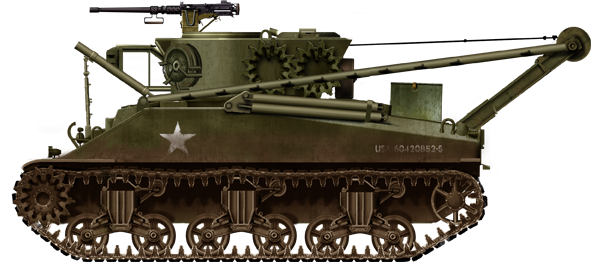
M32 ARV
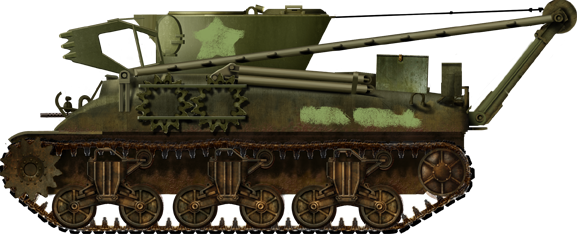
M32B1, French Indochina
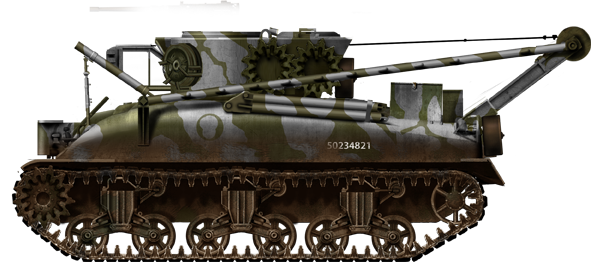
Pakistani M32B1, 1967 war.
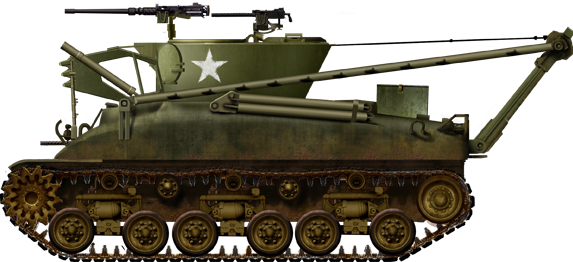
M32A1B1
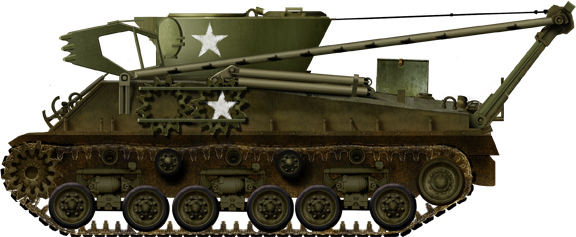
M32A1B3
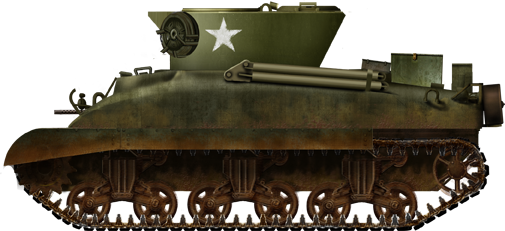
M34 Prime Mover
T1E1 MEX "earthworm" (to come)
More photos
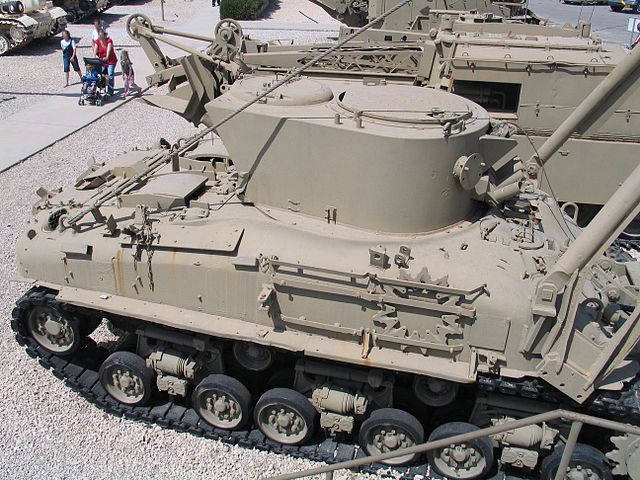
M32 at Latrun Museum
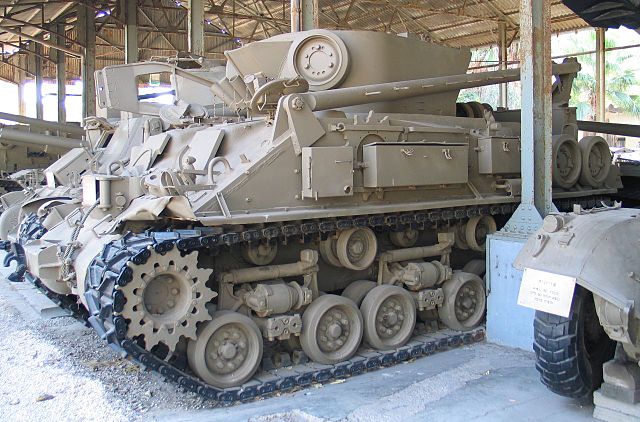
M32A3B3 IDF at batey-haosef
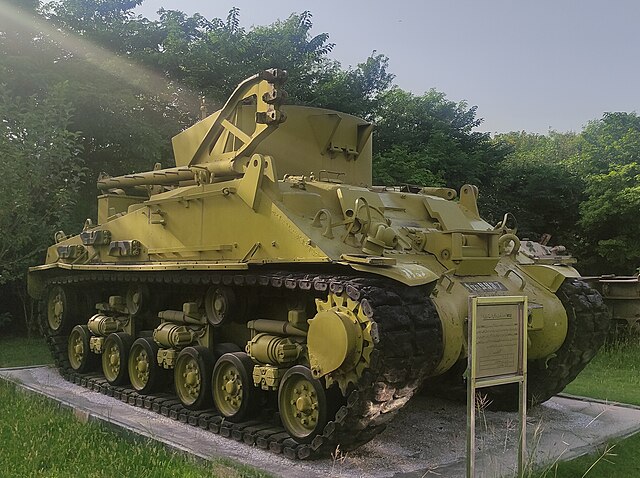
M32A1 Pakistan
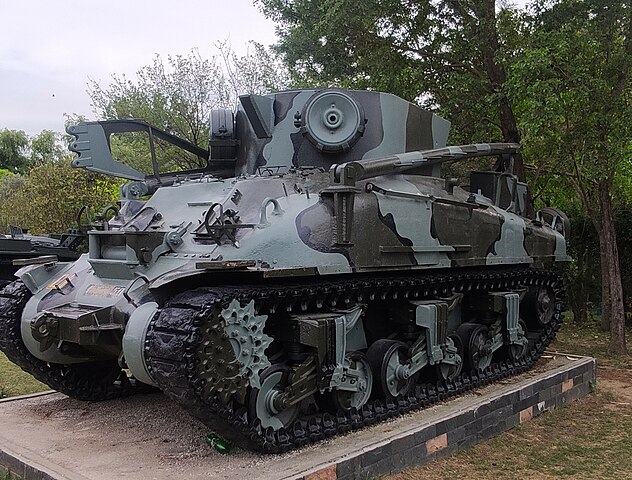
M32B1 Pakistani
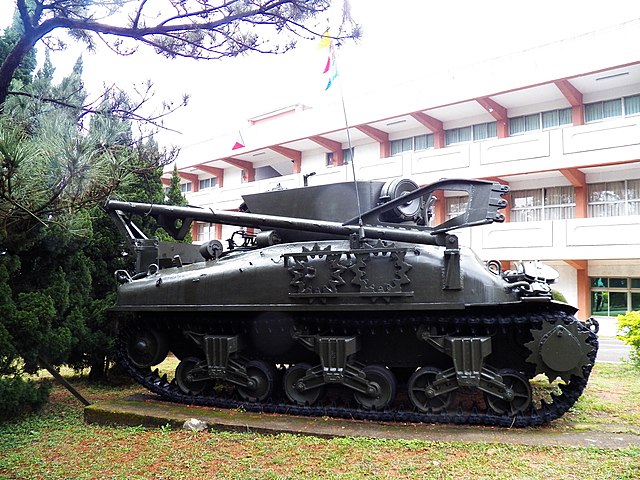
M2B1 at Tanks Park Armor School Taiwan
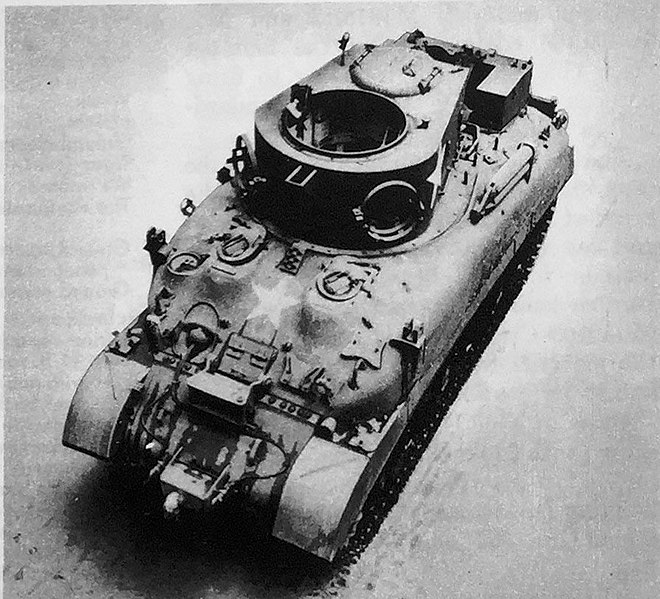
Prime Mover M34
Baldwin Locomotive Works M32B3 Overloon
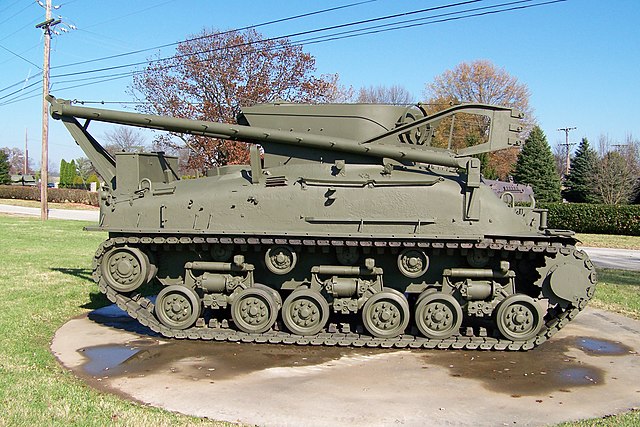
M32A1B1 ARV
M32 M4-A1 at Sinsheim
Sherman_M32_ARV
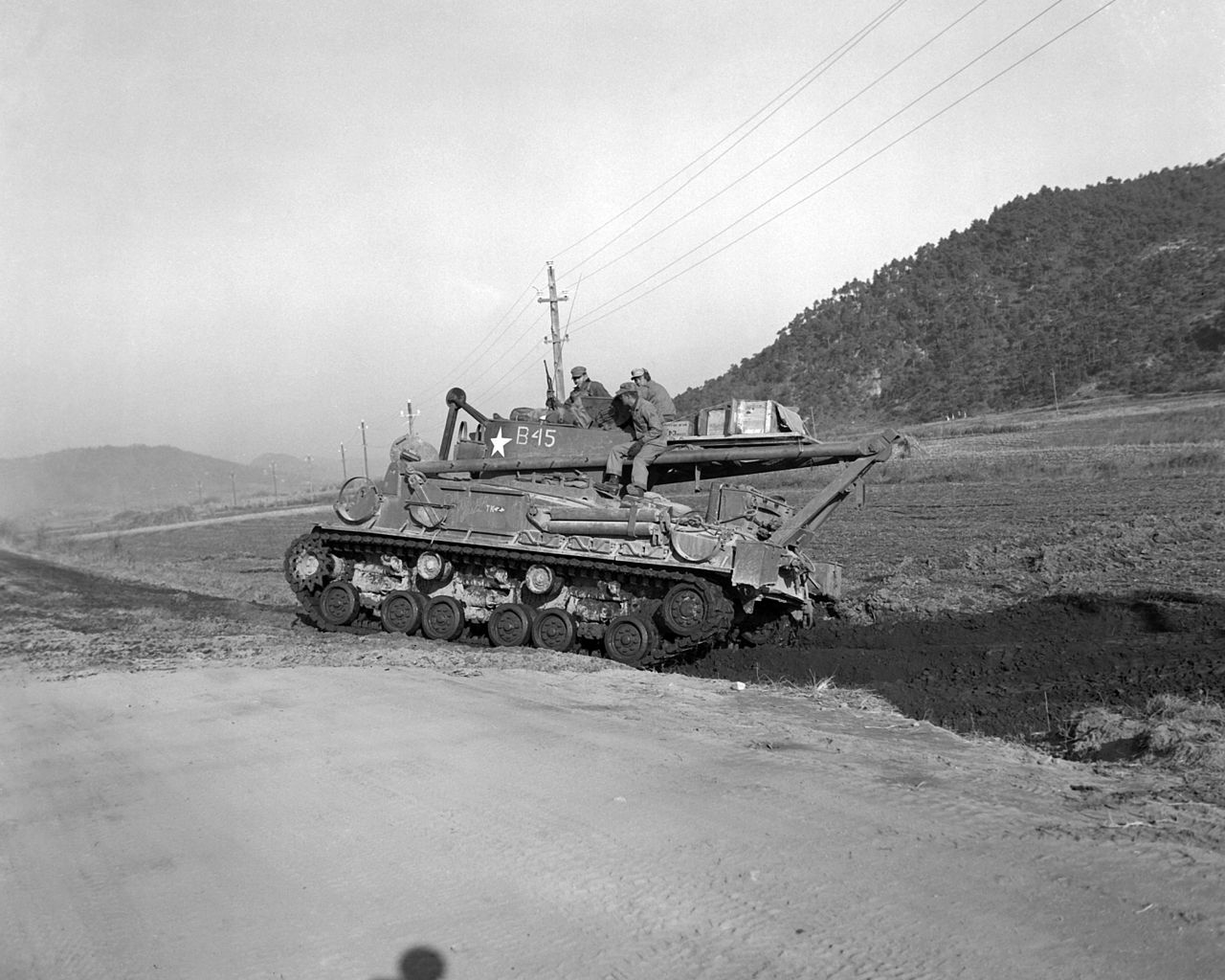
M32A3B3 Hamhung 1950, Korea
Links/Src
Bishop, Chris (2002). The Encyclopedia of Weapons. New York City, New York: Sterling Publishing CompanyBrown, Jerold E. (2001). Historical Dictionary of the U.S. Army. Santa Barbara, California: Greenwood Publishing Group.
Caddick-Adams, Peter (2013). Monte Cassino: Ten Armies in Hell. Oxford, Oxfordshire: Oxford University Press.
Chamberlain, Peter; Ellis, Chris (1969). British and American Tanks of World War II. New York, New York: Arco Publishing Inc.
Doyle, David (2011). Standard Catalog of U.S. Military Vehicles (Second ed.). Iola, Wisconsin: Krause Publications.
Green, Michael (2014). American Tanks & AFVs of World War II. Oxford, Oxfordshire: Osprey Publishing.
Haskew, Michael E. (2016). M4 Sherman Tanks: The Illustrated History of America's Most Iconic Fighting Vehicles. Voyaguer Press.
Hogg, Ian V. (2014). The American Arsenal: The World War II Official Standard Ordnance Catalogue. Barnsley, South Yorkshire: Frontline Books.
Hunnicutt, R.P. (1971). Sherman: A History of the American Medium Tank. Novato, California: Presidio Press.
Ware, Pat (2014). M4 Sherman: Rare Photographs from Wartime Archives Plus Specially Commissioned Colour Illustrations. Barnsley, South Yorkshire: Pen and Sword.
Zaloga, Steven J. (2011). US Field Artillery of World War II. London: Bloomsbury Publishing.
Zaloga, Steven J.; Bryan, Tony; Laurier, Jim (2000). M26/M46 Pershing Tank 1943–1953. New Vanguard. Vol. 35. Oxford, Oxfordshire: Osprey Publishing.
sherman minutia page, best source overall
M30 and M74 series of Armored Recovery Vehicles
Full specs on afvdb.50megs.com
on militaryfactory.com
on theshermantank.com
pinterest board
olive-drab.com
CC photos
on worldwarphotos.info
On panzerserra
wikipedia M32 ARV On wardrawings.be
US Tankers sidearms
Model kits on scalemates
Video

WW2 Tanks




























WW2 tanks posters

All Tiger tanks liveries.

Panther liveries and variants

WW2 Armour - All tanks











Tanks aces and single tanks series

Find more there

Museums, Movies, Books & Games
The Tanks and Armor in pop culture
Tanks and armored vehicles in general are only really grasped when seen first person: The mass, the scale, it's all there. Explore also the way tanks were covered in the movie industry, in books and in video games.Movies:
Best tanks movie on warhistoryonline.com
On imdb.com
On bestsimilar.com/
miltours.com
liveabout.com/
watchmojo.com
Video Games:
pcgamesn.com
historyhit.com
levvvel.com
vg247.com/best-tank-games
mmobomb.com/
alienwarearena.com

